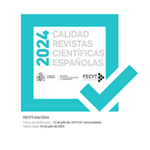Metafísica corrompida del «quo est». Examen comparativo del actus essendi a la luz de la composición «cum his» en las exégesis de Cayetano y Capreolo
Résumé
Sanciona este trabajo la confusión cayetanista en la inspección del actus essendi como esse actualis existentiae, defendiendo el valor del esse desde una recta lectura a propósito de la división capreolista, más ajustada al dictado del Aquinate: ser formal (forma essendi) como complementum substantiae (ordo essentialis in entitate) y esse (actus essendi) como complementum suppositi (ordo subsistendi in entitate). El esse recobra la dignidad metafísica que le otorga Aquino, más densa que el simple valor de existencia, con la diferenciación de una vertiente de composición sustancial (más que esencial, si esta delimitación despertara la tentación de un esse essentiae) y una línea de composición entitativa en la que el esse adquiere relevancia como actus essendi asimilativo, plegados a tal fórmula actus informandi simpliciter (plano de constitución sustancial hilemórfica) y actus subsistendi (plano supositivo, sea como forma pura o como compuesto ex his hilemórfico).
Téléchargements
##submission.format##
Licence
La revista Anales del Seminario de Historia de la Filosofía, para fomentar el intercambio global del conocimiento, facilita el acceso sin restricciones a sus contenidos desde el momento de su publicación en la presente edición electrónica, y por eso es una revista de acceso abierto. Los originales publicados en esta revista son propiedad de la Universidad Complutense de Madrid y es obligatorio citar su procedencia en cualquier reproducción total o parcial. Todos los contenidos se distribuyen bajo una licencia de uso y distribución Creative Commons Reconocimiento 4.0 (CC BY 4.0). Esta circunstancia ha de hacerse constar expresamente de esta forma cuando sea necesario. Puede consultar la versión informativa y el texto legal de la licencia.











